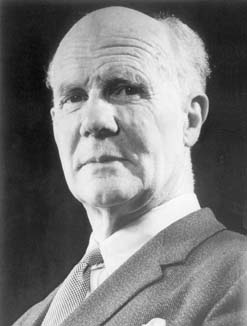Egon Spengler-
Wait...no
Egon Pearson:
What is the probability of having two highly influential statisticians in the same family? One might guess that the likelihood is slim, which makes the Pearson family a rare case indeed. On August 11, 1895, Egon Pearson was born to Maria Sharpe and statistician Karl Pearson in Hampstead, England. Karl Pearson was already renowned for much of his work at the time of Egon’s birth, but it was not before too long that Egon would be making his own place in the statistics field.
Egon began his university studies at the University of Cambridge, where he studied solar physics. However, this was during a time of great turmoil in Europe with the onset of WWI, and Egon’s university education was cut short in 1915 when he decided to enlist in the military. Due to a heart murmur and ongoing poor health, he was rejected from active service but able to contribute to the war efforts by enlisting in the Admiralty and Ministry of Shipping. It was while in the military that Egon was awarded a BA degree by examination, allowing him to begin his career in statistics at the end of the war.
In 1921, Egon joined his father in the Applied Statistics department of the University College of London. Though officially working as a lecturer, Egon gave few lectures at first, instead mostly working under his father on further statistical research. Eventually Egon was allowed to take on more responsibility in lecturing; unfortunately, this was due more to his father’s poor health, preventing his father from lecturing, rather than allowing Egon to lecture due to his own merits.
It was during this time that Egon began to experience increasing cognitive dissonance due to his father’s detractors, particularly his primary rival RA Fisher. Egon himself later wrote, “... I had to go through the painful stage of realizing that K.P. [his father] could be wrong ... and I was torn between conflicting emotions: a. finding it difficult to understand [Fisher], b. hating him for his attacks on my paternal ‘god’, c. realizing that in somethings at least he was right.” This likely only compounded an already complicated relationship existing in the shadow of his prominent father.
After Karl Pearson retired from the Galton Chair of Statistics, the department was split against his wishes into two departments, the department of Eugenics went to Karl’s still rival Fisher, whereas his son Egon was appointed Head of Applied Statistics. In the long view of history, it is arguable the Pearson’s won that split for obvious reasons. Unfortunately the taking of this chair position would later reduce Egon’s ability to work on research, becoming increasingly busy with administrative duties. An argument could be made however that publishing some 133 papers over a lifetime, including such works as The Application of Statistical Methods to Industrial Standardization and Quality Control and The History of statistics in the XVIIth and XVIIIth centuries, might be enough research for anyone to leave a legacy.
Though Egon’s father suffered a career rivalry, Egon was able to work with fellow statistician Jerzy Neyman to develop many novel statistical notions and proofs, including the Neyman-Pearson lemma, perhaps their most well-known contribution to the field of statistics.The Neyman-Pearson lemma is a method for determining what test will offer the most statistical “power” for a given experimental system. When testing two simple hypotheses, H0={θ0} and HA={θA}, the Neyman-Pearson lemma can be used to define the most powerful test of the hypotheses by determining the rejection region (the values at which H0 can be rejected) that corresponds with a specific α. If the rejection region is independent of the value of HA, then the test is most powerful at all values of HA and is termed uniformly most powerful. The Neyman-Pearson lemma is most often used to construct tests, but has unexpectedly been applied in economy with land, when one needs to calculate the best land parcel to purchase from a given heterogeneous land-estate.
Arguably an overlooked contribution of Egon’s was his development and emphasis of the idea of “specification” or explicitly stating the premises assumed behind your chosen tests. This would seem compulsory to any valid use of statistical inference, but as our bad-stats assignment showed, this is still not done regularly enough today.
No comments:
Post a Comment